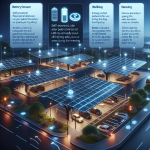Case Studies: Successful Implementation of Solar Carpark Lights
Table of Contents
Case studies on the successful implementation of solar carpark lights provide valuable insights into the practical applications and benefits of renewable energy solutions in urban infrastructure. These studies highlight various projects where solar-powered lighting systems have been effectively integrated into parking facilities, showcasing their impact on energy efficiency, cost savings, and environmental sustainability. By examining real-world examples, these case studies demonstrate how solar carpark lights can enhance safety, reduce carbon footprints, and offer a reliable alternative to traditional grid-powered lighting. They also explore the challenges faced during implementation and the innovative strategies employed to overcome them, offering a comprehensive understanding of the potential and versatility of solar technology in modern urban planning.
Benefits Of Solar Carpark Lights: A Case Study Analysis
The implementation of solar carpark lights has been a transformative development in the realm of sustainable infrastructure. This article delves into the benefits of solar carpark lights through a detailed analysis of various case studies, highlighting the multifaceted advantages that these systems offer. By examining real-world examples, we can better understand the practical implications and the overarching benefits that solar carpark lights bring to communities and businesses alike.
One of the most compelling benefits of solar carpark lights is their contribution to environmental sustainability. For instance, a case study from a shopping mall in California demonstrated a significant reduction in carbon emissions after installing solar-powered lighting. The mall’s management reported a decrease in their carbon footprint by approximately 20 tons annually. This reduction was primarily due to the elimination of reliance on grid electricity, which is often generated from fossil fuels. Consequently, the adoption of solar carpark lights not only supports the fight against climate change but also promotes a cleaner, healthier environment.
In addition to environmental benefits, solar carpark lights offer substantial economic advantages. A notable example can be found in a municipal carpark in Sydney, Australia. The local government invested in solar lighting to cut down on energy costs. Over a five-year period, the city reported savings of over $100,000 in electricity bills. These savings were redirected towards other community projects, thereby enhancing the overall quality of public services. Furthermore, the initial investment in solar technology was offset by government incentives and rebates, making the transition financially viable.
Another significant benefit is the enhancement of safety and security. A case study from a university campus in the United Kingdom revealed that the installation of solar carpark lights led to a 30% reduction in nighttime incidents. The improved illumination provided by these lights deterred criminal activities and made the carpark safer for students and staff. The university also noted that the consistent lighting, unaffected by power outages, ensured continuous security throughout the night. This case underscores the importance of reliable lighting in maintaining a secure environment.
Moreover, solar carpark lights are known for their low maintenance requirements. A corporate office in Tokyo, Japan, serves as an excellent example. The office complex installed solar carpark lights equipped with LED technology, which has a longer lifespan compared to traditional lighting solutions. Over a span of ten years, the maintenance costs were minimal, primarily involving occasional cleaning and battery replacements. This low-maintenance aspect not only reduces operational costs but also ensures uninterrupted service, thereby enhancing user satisfaction.
Furthermore, the aesthetic appeal of solar carpark lights cannot be overlooked. A residential complex in Dubai incorporated solar lighting into their carpark design, which significantly improved the visual appeal of the area. The sleek, modern design of the solar lights complemented the architecture of the complex, creating a visually pleasing environment. This enhancement in aesthetics also contributed to an increase in property value, demonstrating that solar carpark lights can be a valuable asset in real estate development.
In conclusion, the successful implementation of solar carpark lights, as evidenced by these case studies, highlights a range of benefits including environmental sustainability, economic savings, enhanced safety, low maintenance, and improved aesthetics. These advantages collectively make a compelling case for the widespread adoption of solar carpark lights. As communities and businesses continue to seek sustainable and cost-effective solutions, solar carpark lights stand out as a prudent and forward-thinking choice.
Overcoming Challenges In Solar Carpark Light Installations: Real-World Examples

The successful implementation of solar carpark lights often involves overcoming a myriad of challenges, ranging from technical difficulties to environmental considerations. Real-world examples provide valuable insights into how these obstacles can be effectively managed, ensuring that solar carpark lighting systems not only function optimally but also deliver long-term benefits.
One notable case study is the installation of solar carpark lights at a large shopping center in California. Initially, the project faced significant hurdles due to the area’s inconsistent sunlight exposure, which could potentially affect the efficiency of the solar panels. To address this, the project team conducted a thorough site analysis to identify the optimal locations for the solar panels, ensuring maximum sunlight capture. Additionally, they incorporated advanced battery storage systems to store excess energy generated during peak sunlight hours. This approach not only mitigated the risk of power shortages during cloudy days but also enhanced the overall reliability of the lighting system.
Transitioning to another example, a university campus in Australia successfully implemented solar carpark lights despite facing budget constraints. The project team adopted a phased installation strategy, prioritizing high-traffic areas first to maximize immediate benefits. By doing so, they were able to demonstrate the effectiveness of the solar lighting system, which subsequently facilitated additional funding for the project’s expansion. Furthermore, the team leveraged government incentives and grants aimed at promoting renewable energy solutions, thereby alleviating some of the financial burdens. This strategic approach underscores the importance of resourcefulness and phased implementation in overcoming budgetary challenges.
In a different context, a municipal carpark in Germany encountered regulatory and compliance issues during the installation of solar carpark lights. The local regulations required extensive documentation and adherence to specific standards, which initially delayed the project. To navigate these challenges, the project team engaged with regulatory bodies early in the planning phase, ensuring that all requirements were clearly understood and met. They also employed a dedicated compliance officer to oversee the project, ensuring that all installations adhered to the stipulated guidelines. This proactive engagement with regulatory authorities not only expedited the approval process but also set a precedent for future renewable energy projects in the region.
Moreover, environmental challenges can also pose significant obstacles to the implementation of solar carpark lights. For instance, a coastal town in Spain had to contend with the corrosive effects of saltwater on the solar panels and lighting fixtures. To overcome this, the project team selected materials specifically designed to withstand harsh coastal conditions, such as corrosion-resistant coatings and marine-grade stainless steel. Additionally, they implemented regular maintenance schedules to ensure the longevity and efficiency of the solar lighting system. This case study highlights the importance of selecting appropriate materials and maintenance practices to address environmental challenges effectively.
In conclusion, the successful implementation of solar carpark lights is often contingent upon the ability to overcome various challenges, whether they be technical, financial, regulatory, or environmental. Real-world examples from diverse settings illustrate that with careful planning, strategic resource allocation, and proactive engagement with stakeholders, these obstacles can be effectively managed. By learning from these case studies, future projects can be better equipped to navigate the complexities of solar carpark light installations, ultimately contributing to the broader adoption of sustainable and renewable energy solutions.
Cost Savings And Efficiency: Case Studies On Solar Carpark Light Projects
The implementation of solar carpark lights has proven to be a cost-effective and efficient solution for various organizations and municipalities. By examining several case studies, we can better understand the tangible benefits and operational efficiencies that these projects have delivered. One notable example is the installation of solar carpark lights at a large retail complex in California. Prior to the installation, the complex relied on traditional grid-powered lighting, which resulted in high electricity bills and frequent maintenance issues. By transitioning to solar-powered lights, the complex not only reduced its energy costs but also minimized its carbon footprint. The initial investment was offset by the significant savings on electricity bills, and the maintenance costs were drastically reduced due to the longer lifespan and lower failure rates of the solar lights.
Similarly, a municipal carpark in Sydney, Australia, experienced remarkable improvements after switching to solar lighting. The city council aimed to enhance public safety while reducing operational costs. The solar carpark lights provided consistent and reliable illumination, which improved visibility and security for both pedestrians and vehicles. The council reported a 40% reduction in energy expenses within the first year, and the project paid for itself within three years. This case study highlights the dual benefits of cost savings and enhanced public safety, making it a compelling example for other municipalities considering similar projects.
In another instance, a university in the United Kingdom implemented solar carpark lights across its campus. The university’s sustainability goals included reducing its carbon emissions and promoting renewable energy sources. The solar lights not only contributed to these goals but also provided a practical solution to the university’s budget constraints. The project was funded through a combination of government grants and private investments, demonstrating the feasibility of public-private partnerships in advancing sustainable infrastructure. The university reported a 50% reduction in lighting costs and a significant decrease in maintenance requirements, allowing them to allocate resources to other critical areas.
Moreover, a corporate office park in Germany adopted solar carpark lights as part of its broader sustainability initiatives. The office park management sought to create an eco-friendly environment while reducing operational costs. The solar lights were integrated with smart technology, allowing for remote monitoring and control. This integration enabled the management to optimize lighting schedules and detect any issues in real-time, further enhancing efficiency. The project resulted in a 45% reduction in energy consumption and a notable decrease in maintenance costs. The success of this project underscores the potential for integrating advanced technologies with renewable energy solutions to achieve greater efficiencies.
These case studies collectively illustrate the diverse applications and benefits of solar carpark lights. From retail complexes and municipal carparks to university campuses and corporate office parks, the transition to solar lighting has consistently resulted in substantial cost savings and operational efficiencies. The initial investment in solar technology is often recouped within a few years, making it a financially viable option for many organizations. Additionally, the environmental benefits, such as reduced carbon emissions and decreased reliance on non-renewable energy sources, further enhance the appeal of solar carpark lights. As more organizations recognize these advantages, the adoption of solar lighting solutions is likely to continue growing, contributing to a more sustainable and cost-efficient future.
Read more about Solar Carpark Lights:
- Introduction to Solar Carpark Lights
- Types of Solar Carpark Lights
- Factors to Consider when Choosing Solar Carpark Lights
- Installation and Maintenance of Solar Carpark Lights
- Top Brands in the Solar Carpark Light Industry
- Innovative Features of Solar Carpark Lights
- Practical Applications of Solar Carpark Lights
- Future Developments in Solar Carpark Lights
- Frequently Asked Questions about Solar Carpark Lights









